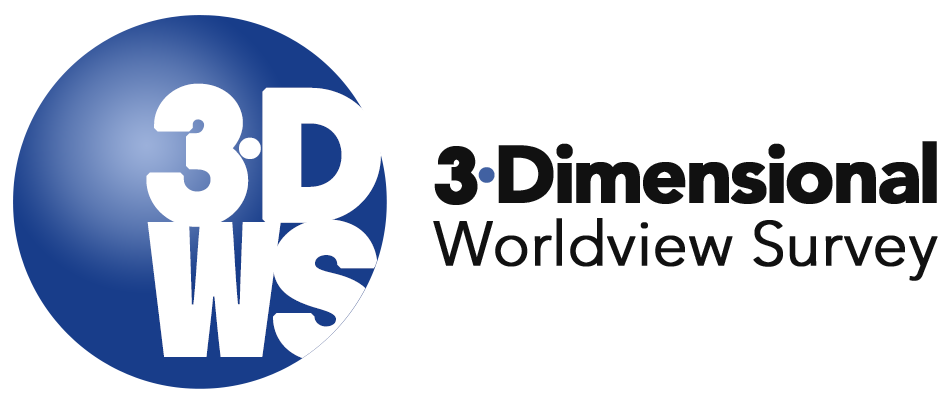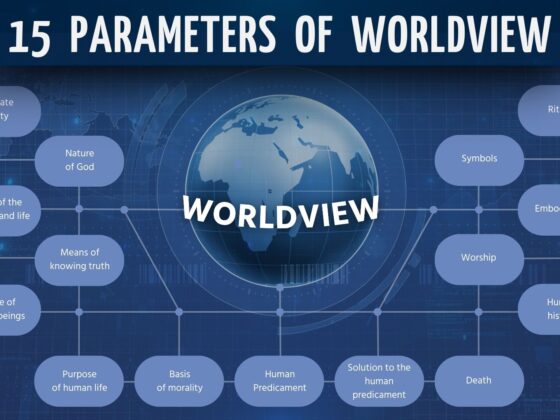Tools for Teaching Comparative Worldview
February 14, 2023
Katherine Schultz
Worldview Defined
In order to teach comparative worldview, we need a common definition of the term. The 3-dimensional worldview that is the basis of this website and the 3-D Worldview Survey comes from James Sire’s (2009) definition in The Universe Next Door:
A worldview is a commitment, a fundamental orientation of the heart, that can be expressed as a story or in a set of presuppositions (assumptions which may be true, partially true, or entirely false) which we hold (consciously or subconsciously, consistently or inconsistently) about the basic constitution of reality, and that provides the foundation on which we live and move and have our being. (Sire, 2009, 20)
The 3 dimensions in this definition are propositional (beliefs), behavioral, and heart-orientation (attitudes). The propositional dimension is the presuppositional or assumption dimension of worldview: what a person thinks, knows, or believes to be true. The behavioral dimension of worldview is that which a person does: the “live and move” of every day. The definition of heart in use for this study is “the religious, intellectual, affective, and volitional center of a person” (Naugle, 2002, 270).
Teaching Comparative Worldviews
One way to teach comparative worldviews is to identify a framework of questions or topics and then summarize the way an adherent of each worldview being considered would approach it. For example, in The Universe Next Door, author James Sire poses the question “What is prime reality–the really real?” (Sire, 2009, 22). This question of metaphysics overlaps with theology, and different worldviews would answer it differently. Here is a sample:
- Biblical Theism: A Creator God who sustains and relates to the universe
- Deism: God created the universe and left it alone
- Naturalism: Matter is ultimately all that really exists
- Postmodernism: Reality is socially constructed by those in power
Sire has seven more questions that help understand worldviews, and he explains how each of 9 worldviews would answer them (see chart for a sample from Biblical Christian Theism). The questions cover the nature of reality, human identity, what happens after death, ethics, knowledge, and heart orientation.
Worldviews should be consistent, coherent, and comprehensive. Asking a person questions about what they believe, how they act, and what their preferences or hopes are can help reveal their worldview. Sometimes a person will have a consistent worldview that holds together. But other times, a person (maybe even the same person) will borrow from various worldviews based on experiences, preferences, and desires. This results in an inconsistent worldview–perhaps without the person even realizing it. Teaching comparative worldview can help a person recognize where their worldview is not lined up with what they want it to be, and can help them better form a coherent and consistent worldview. And asking good questions can help reveal a person’s worldview.
Biblical Christian Theism Answers to Worldview Questions
As an example, here is a summary of how Sire answers the 8 worldview questions when defining Biblical Christian Theism. Page references are to the 5th edition of The Universe Next Door (Sire, 2009).
| 1. The Ultimate: What is prime reality–the really real? (metaphysics, theology) | Creator God sustains and relates to the universe (p. 28) |
| 2. Nature: What is the nature of external reality, that is, the world around us? (ontology) | Responsibly managed by humans for God’s glory and human good (p. 31) |
| 3. Human Identity: What is a human being? (anthropology, sociology) | Being in God’s image, but nevertheless sinful (p. 32, 38) |
| 4. Death: What happens to a person at death? | Judged on basis of God’s forgiveness (p. 41) |
| 5. Knowledge: Why is it possible to know anything at all? (epistemology) | God’s revelation plus reason (look up and out) (p. 36) |
| 6. Ethics: How do we know what is right and wrong? (ethics, morality) | Universal, involving rights and responsibilities (p. 42) |
| 7. History: What is the meaning of human history? | Shaped by God’s sovereignty and human choice (p. 43) |
| 8. Heart-Orientation: What personal, life-orienting core commitments are consistent with this worldview? | Seek first the kingdom of God (p. 44) |
Sire also provides answers to these questions from 8 other worldviews: Deism, Naturalism, Nihilism, Existentialism, Eastern Pantheistic Monism, New Age Spirituality, Postmodernism, and Islamic Theism.
If you’d like help with questions that you can ask to understand someone’s worldview, check out this free resource.
Resources for Teaching Worldview
If you are looking for resources for teaching comparative worldview, I suggest Sire’s book, The Universe Next Door. Be sure to get the 4th edition or later so that you have the information Sire added about heart-orientation in the definition above.
Yes, I realize additional visual and explanatory resources for teaching comparative worldviews may also be helpful, so here is a list with brief commentary.
Summit Ministries Worldview Chart
- Description: Chart comparing 6 worldviews (Biblical Christianity, Islam, Secularism, Marxism, New Spirituality, Postmodernism) in 10 areas (thology, philosophy, ethics, biology, psychology, sociology, law, politics, economics, history), with additional link to descriptions that further help understanding.
- Audience: high school/college students
- Link: https://www.summit.org/resources/worldview-chart/
Rasi, Umberto. “Worldviews, Contemporary Culture, and Adventist Thought”
- Description: Provides a summary chart similar to Sire’s for three worldviews: theism, naturalism, pantheism in 10 parameters (prime reality, nature of God, origin of universe and life, means of knowing truth, nature of human beings, purpose of human life, basis of morality, human predicament, solution to human predicament, death, human history, ultimate human destiny). Support for classroom teachers seeking to develop a worldview in their students. Though it’s written for an Adventist audience, it has broad application.
- Audience: academic/scholarly
- Link: https://christintheclassroom.org/vol_26B/26b-cc_001-016.pdf
Fisher, Barbara. “Exploring Worldviews: A Framework”
- Description: Updates Rasi’s table slightly; the article a general framework for exploring a worldview—in terms of defining, analyzing, developing, testing and refining it.
- Audience: academic/scholarly
- Link: https://research.avondale.edu.au/teach/vol6/iss1/11/
Generation Word Worldview Chart
- Description: Very similar to Summit Ministries (as noted on the link), with the same 6 worldviews and 10 topics.
- Audience: general
- Link: https://www.generationword.com/photos/worldview_chart_gw3.gif
Worldview Chart
- Description: Chart comparing 6 worldviews (theism, deism, polytheism, panentheism, pluralism, naturalism) in 5 areas (metaphysics, theology, epistemology, ethical, anthropological).
- Audience: general
- Link: https://i1064.photobucket.com/albums/u376/mrwormburn/TRIN2005.jpg
What’s Your Worldview — article
- Description: Article with several links, particularly aimed at how the items linked can be used in evangelistic and apologetics conversations.
- Audience: general
- Link: https://davemiers.com/whats-your-worldview/ (includes links to the What’s Your Worldview adventure and Worldview Summary links below)
What’s Your Worldview — adventure
- Description: Sort of a “create your own adventure” path with a series of statements for various levels of agreement beginning with “God exists,” taking the next step of question based on the previous answer. Fourteen possible results: polytheist, pantheist, atheist, apatheist, agnostic, nihilist, deist, theist, existentialist, panentheist, humanist, naturalist, relativist, Christian theist.
- Audience: general
- Link: https://davemiers.com/wp-content/uploads/2014/07/worldview_survey2.jpg
Worldview Summary graphic organizer
- Description: A graphic organizer of brief descriptions of each of 14 worldviews (agnosticism, apatheism, atheism, Christian theism, deism, existentialism, humanism, naturalism, nihilism, panentheism, pantheism, polytheism, relativism, theism. A good partner source to go with the What’s Your Worldview adventure graphic.
- Audience: general
- Link: https://visualunit.me/2011/12/19/worldview-summary/
Worldview Chart layers of the onion graphic
- Description: A visual with 4 layers of how to understand someone’s worldview: observable behavior, socio-cultural, values, worldview. Shows the relationship between these, and has notes on the insider vs outsider perspective on someone’s worldview.
- Audience: general
- Link: https://www.garydavidstratton.com/wp-content/uploads/2010/12/worldview-chart.png
Islamic Worldview Prezi
- Description: Prezi collection (about 25 “slides”) giving an introduction to the Islamic worldview. Includes a brief comparison between the Islamic and western worldviews.
- Audience: college students or adults
- Link: https://prezi.com/l5ixjf53sh-j/islamic-worldview/
Worldview and Apologetics Prezi
- Description: Prezi collection (about 70 “slides”) giving an overview of worldview as a “solar system” of center, self, other people, nature, and God as the “planets.” Gives historical development of worldviews and apologetics with a timeline from about 6000 BC to the 21st century.
- Audience: college students or adults
- Link: https://prezi.com/ilmaz0wmoc6w/worldview-and-apologetics/
Failure of Christian Leadership Side-by-Side Mature vs Immature Biblical Worldview
- Description: Chart showing how a mature biblical worldview should influence every area of life and policy versus an immature view that limits the impact of a biblical worldview to the religious realm. Particularly from an American historical perspective.
- Audience: general
- Link: http://www.godgov.org/sitebuildercontent/sitebuilderpictures/NewsestWVChart.jpg
Where to begin in teaching comparative worldview?
It can be overwhelming to teach comparative worldview, particularly if you don’t know where your students are in their own worldview development. If you’d like help with questions that you can ask to understand someone’s worldview, check out this free resource.
References
Naugle, D. K. (2002). Worldview: The History of a Concept. Eerdmans Publishing Company.
Sire, J. W. (2009). The Universe Next Door: A Basic Worldview Catalog (5th ed.). InterVarsity Press.





